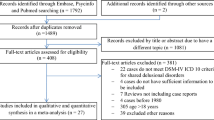Abstract
Folie à deux (FAD) was first described in 19th century France. Since then, the concept has been elaborated, and several subtypes of FAD have been successively reported in France. In contrast, studies in German-speaking psychiatry mainly focused on the conceptual boundary between reactive/endogenous psychosis and etiological hypothesis (ie, psychogenesis vs genetic predisposition). In North America, Gralnick wrote a seminal review and redefined four subtypes of FAD by adopting the European classical concepts. More recently, “shared psychotic disorder” in DSM or “induced delusional disorder” in ICD-10 was branched off from FAD. However, several classical subcategories of FAD were not included in these recent definitions, the nosological significance of which should not be underestimated. We examined demographic data of FAD case reports published from the 19th to the 21st century and found that some of the earlier hypotheses, such as females being more susceptible, older and more intelligent individuals being more likely to be inducers, and sister-sister pairs being the most common relationship, were not supported. The controversial issue of the etiology of FAD—association of subjects or genetically driven psychosis—was re-examined in light of recent studies.
Similar content being viewed by others
References and Recommended Reading
Lasègue C, Falret J: La folie à deux ou folie communiqué [in French]. Ann Med Psychol 1877, 18:321–355.
Fenning S, Fochtmann LJ, Bromet EJ: Delusional disorder and shared psychotic disorder. In Kaplan & Sadock’s Comprehensive Textbook of Psychiatry, vol 1. Edited by Sadock BJ, Sadock VA. New York: Lippincott Williams & Wilkins; 2005:1525–1533.
Legrand du Saulle H: Idées de Persécution Communiquées ou Délire à Deux et à Trois Personnes. Le Délire des Persécutions, Paris: Henri Plon; 1871.
Régis E: La Folie à Deux ou Folie Simultannée Avec Observations Recueillies à la Clinique de Pathologie Mentale (Thèse). Paris: Baillière; 1880.
Marandon de Montyel E: Des conditions de la contagion mentale morbide. Ann Med Psych 1894, 7:266–293, 467–487.
Defendorf AR: Folie à deux. In Reference Handbook of the Medical Sciences. 1902:5–135.
Clérambeaut G: Œuvre Psychiatrique. Paris: PUF; 1988:1–89.
Lehman G: Zur casuistik des induzirten irreseins (Folie à deux). Arch Psychiatr 1883, 14:145–154.
Scharfetter C: On the hereditary aspects of symbiotic psychoses. A contribution towards the understanding of the schizophrenia-like psychoses. Psychiatr Clin (Basel) 1970, 3:145–152.
Ast F: Allg.Zschr.f.Psychiatr 1906, 63:41.
Shinohara D: On induced psychosis [in Japanese]. Seishin Shinkeigaku Zasshi 1959, 61:2035–2055.
Bonhoeffer K: Allg.Zschr.f.Psychiatr 1911, 68:371.
Jaspers K: Allgemeine Psychopathologie. Berlin: Springer; 1953.
Schneider K: Psychiatrie Heute. Translated into Japanese by Hirase S, Kanokogi T. Tokyo: Bunkodo; 1957.
Gralnick A: Folie à deux—the psychosis of association. Psychiatr Q 1942, 16:230–236, 491–520.
Dewhurst K, Todd J: The psychosis of association — folie à deux. J Nerv Ment Dis 1956, 124:451–459.
Munro A: Folie à deux revisited. Can J Psychiatry 1986, 31:233–234.
American Psychiatric Association: Diagnostic and Statistical Manual of Mental Disorders, edn 3. Washington, DC: American Psychiatric Association; 1980.
Mentjox R, van Houten CA, Kooiman CG: Induced psychotic disorder: clinical aspects, theoretical considerations, and some guidelines for treatment. Compr Psychiatry 1993, 34:120–126.
American Psychiatric Association: Diagnostic and Statistical Manual of Mental Disorders, edn 4. Washington, DC: American Psychiatric Association; 1994.
World Health Organization: The ICD-10 Classification of Mental and Behavioral Disorders, edn 10. Geneva: World Health Organization; 1992.
Silveira JM, Seeman MV: Shared psychotic disorder: a critical review of the literature. Can J Psychiatry 1995, 40:389–395.
Arnone D, Patel A, Tan GM: The nosological significance of Folie à Deux: a review of the literature. Ann Gen Psychiatry 2006, 5:11.
Sharon R, Eliyahu Y, Shteynman S. Shared psychotic disorder. [WebMD website]. Available at: http://www.emedicine.com/med/topic3352.htm Accessed February 2007.
Kashiwase H, Kato M: Folie à deux in Japan — analysis of 97 cases in the Japanese literature. Acta Psychiatr Scand 1997, 96:231–234.
White TG: Folie simultanée in monozygotic twins. Can J Psychiatry 1995, 40:418–420.
Shiwach RS, Sobin PB: Monozygotic twins, folie à deux and heritability: a case report and critical review. Med Hypotheses 1998, 50:369–374.
Lazarus A: Folie à deux in identical twin: interaction of nature and nurture. Br J Psychiatry 1986, 148:324–326.
Kendler KS, Robinson G, McGuire M, Spellman MP: Late onset folie simultanée in a pair of monozygotic twins. Br J Psychiatry 1986, 148:463–465.
Shimizu M, Kubota Y, Calabrese JR, et al.: Analysis of delusional statements from 15 Japanese cases of ‘Folie à Deux.’ Psychopathology 2006, 39:92–98.
Shimizu M: Folie à deux in schizophrenia—“psychogenesis” revisited. Seishin Shinkeigaku Zasshi 2004, 106:546–563.
Patel AS, Arnone D, Ryan W: Folie à deux in bipolar affective disorder: a case report. Bipolar Disord 2004, 6:162–165.
Dantendorfer K, Maierhofer D, Musalek M: Induced hallucinatory psychosis (folie à deux hallucinatoire): pathogenesis and nosological position. Psychopathology 1997, 30:309–315.
Joshi KG, Frierson RL, Gunter TD: Shared psychotic disorder and criminal responsibility: a review and case report of folie à trois. J Am Acad Psychiatry Law 2006, 34:511–517.
Author information
Authors and Affiliations
Corresponding author
Rights and permissions
About this article
Cite this article
Shimizu, M., Kubota, Y., Toichi, M. et al. Folie à Deux and shared psychotic disorder. Curr Psychiatry Rep 9, 200–205 (2007). https://doi.org/10.1007/s11920-007-0019-5
Published:
Issue Date:
DOI: https://doi.org/10.1007/s11920-007-0019-5




